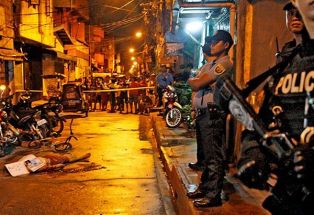DOH declares national dengue alert

MANILA, Philippines — Due to rapidly increasing cases of dengue in several regions, the Department of Health (DOH) declared yesterday a National Dengue Alert.
At a press conference, Health Secretary Francisco Duque III said that Code Blue Alert has also been raised for the National Disaster Risk Reduction and Management Council (NDRRMC) health cluster.
This means that there should be heightened surveillance by the DOH’s regional offices for dengue and heightened implementation of anti-dengue strategies.
The regions where the alert status has been raised are Mimaropa, Western Visayas (Region VI), Central Visayas (Region VII) and Northern Mindanao (Region X).
Duque disclosed that clustering of cases must be identified by the DOH regional office as a basis for declaring a localized epidemic at the barangay level.
He added the regions being monitored are Ilocos, Cagayan Valley, Calabarzon, Bicol, Eastern Visayas, Zamboanga peninsula, Davao, Bangsamoro Autonomous Region in Muslim Mindanao and Cordillera Administrative Region.
DOH data show that from Jan. 1 to June 29 this year, there were 106,630 cases recorded nationwide. This is 85 percent higher compared to the same period last year wherein 57,564 cases were recorded.
In declaring a national alert, Duque said “the objective is very clear: we want to raise awareness among the public and, more importantly, in communities where signs of early dengue increases are evident.”
Most of the cases came from Western Visayas (13,164), Calabarzon (11,474), Central Visayas (9,199), Soccsksargen (9,107) and Northern Mindanao (8,739).
He said that dengue cases have been observed to peak every three to four years, with one of four dengue strains becoming predominant every year.
However, those who got infected with a certain strain get lifetime immunity from that strain. This means that a person could get dengue four times in a lifetime.
WHO warning
World Health Organization (WHO) country representative Gundo Weiler warned the government that with the current data on dengue, the Philippines must brace for severe dengue this year.
Weiler said the rise in dengue can be attributed to various factors, including migration and climate change.
He said that what the Philippines is experiencing is also happening in other countries in the region like Cambodia, Vietnam, Malaysia and Singapore.
“So, the situation is not so unique in the Philippines. Dengue globally is a huge issue. More than half of the world’s population is living in areas where there is exposure to dengue,” he added.
“There are lots of efforts we can do and we can alleviate severity of dengue outbreak. Like if we pursue some of the simple community measures – search and destroy the breeding sites of mosquitoes and self protection against mosquito bites,” he added.
The DOH had also declared a dengue outbreak in the provinces of Iloilo, Capiz, Aklan, Antique and Guimaras, while Negros Occidental has been placed under alert status.
The pronouncement came after Duque declared a National Dengue Alert over the increasing number of dengue cases in several regions.
Duque made the pronouncement in a video conference with members of the local media and DOH-CHD 6 in Mandurriao district, Iloilo City.
In a bid to prevent more dengue cases, he also called for action and collaboration of all stakeholders and health partners to work together.
Officials of Guimaras and Capiz had declared a dengue outbreak last Friday.
Guimaras Gov. Samuel Gumarin signed Executive Order 36 declaring the outbreak, citing a 1,046 percent increase in the number of dengue cases in the province.
At least 493 cases with two deaths were recorded in the province from January to July 6.
Capiz Gov. Esteban Evan Contreras declared the outbreak under EO 1, which also ordered provincial and district hospitals to provide free medical services to dengue patients.
Contreras said local government units (LGUs) should institute preventive mechanisms to avert the spread of the disease. He said LGUs should also conduct “Kontra Dengue Day.”
Capiz recorded 2,177 dengue cases with 14 deaths from Jan. 1 to June 29.
He also ordered the creation of committees and task forces to intensify Aksyon Barangay Kontra Dengue, enhanced 4S strategy and the 4 o’clock habit drive against dengue.
Last Friday, Iloilo Gov. Arthur Defensor Jr. signed EO 016 declaring a dengue outbreak and ordering a cleanup drive for four consecutive Saturdays, starting July 6.
Two students at the Maasin Central Elementary School are the latest fatalities, which also prompted a declaration of a dengue outbreak in Maasin. The town recorded 170 dengue cases.
DOH Region 9 office reported yesterday that 48 people have already died from dengue since January in the Zamboanga peninsula and Isabela City.
Emilia Monicimpo, DOH Region 9 director, said the dengue cases in the region have reached an alarming level as the cases doubled within just the second quarter compared to the year-ago period.
Monicimpo said Zamboanga City health officials recorded 14 deaths, followed by Ipil town, Zamboanga Sibugay with six deaths, Dipolog City in Zamboanga del Norte with four and Pagadian City, Zamboanga del Sur and Isabela City with three each.
She said that the dengue cases increased by 285 percent or a total of 8,076 cases from January to July 6 this year compared to 2,067 cases last year of the same period.
Last week, two school campuses temporarily suspended classes due to mosquito swarm which turned out to be dengue carrier mosquito based on the laboratory test.
Senate President Pro Tempore Ralph Recto said yesterday that screened windows and doors should be installed in public schools to prevent the spread of dengue.
He said during school days, one in four Filipinos are in public schools, based on his computation from 27 million students taught by 830,000 teachers in about 47,000 schools this year.
Schoolchildren, he said, form the largest group of dengue victims, the number of which surged to 98,179 between January and June from 53,475 the DOH recorded during the same period last year.
He said screening off ventilation points in classrooms is not a new idea.
In 2015, there was already a plan by the DOH to install screens in 20,000 classrooms, to add to 7,620 classrooms which were already installed with chemically treated screens, Recto said.
To cope with the annual increase in enrollment, DepEd needs 10,000 new classrooms. This is on top of the existing backlog of 64,668 classrooms that must be wiped out to achieve the ideal pupil-to-room ratio. – With Paolo Romero, Roel Pareño, Jennifer Rendon
- Latest
- Trending






























